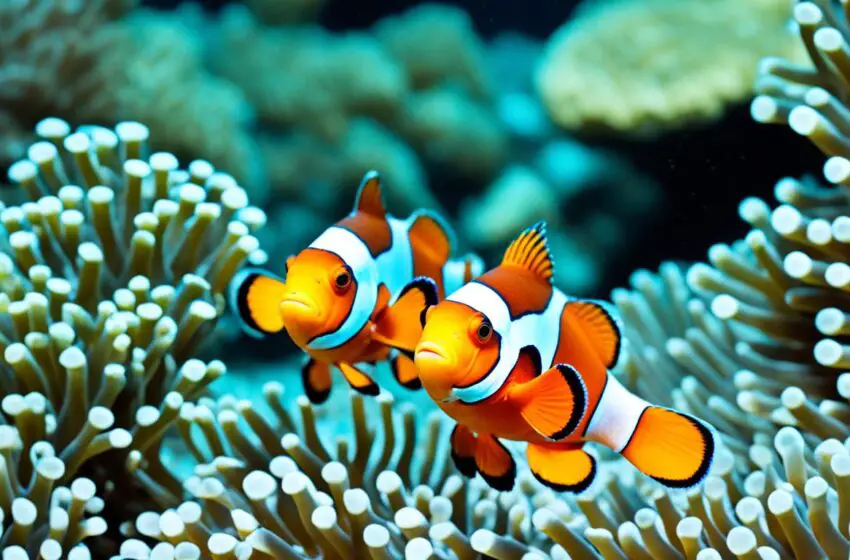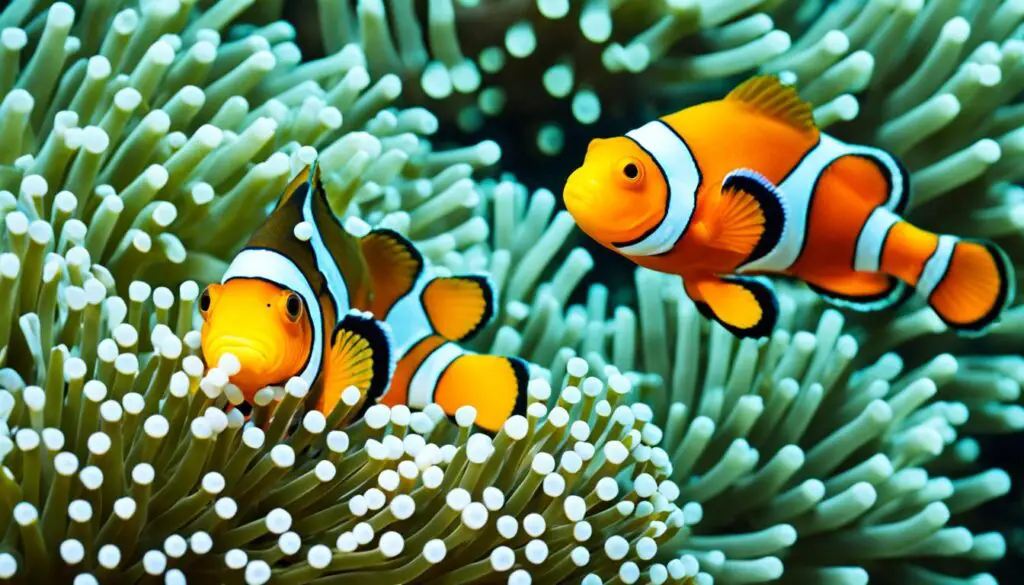Building Bonds: The Art of Pair Bonding in Clownfish

Clownfish have a special way of forming strong bonds called pair bonding. This is important for them to breed well. It also helps them live peacefully in fish tanks. The method they use is quite unique. The female lays eggs, and then the male fertilizes them outside her body.
I’ll show you how to make these fish get along well in your tank. We’ll talk about what it takes to care for them correctly. This will help your underwater world to be lively and colorful.
Key Takeaways:
- Pair bonding in clownfish is essential for successful breeding and harmonious aquarium relationships.
- Understanding the process of pair bonding in clownfish helps create a thriving marine environment.
- Proper care and considerations ensure the well-being of clownfish and their offspring.
- Creating an ideal environment with clean water, live rock, and suitable lighting promotes pair bonding.
- Monitoring the behavior and physical changes of female clownfish indicates readiness for spawning.
Selecting a Mated Pair or Creating Your Own Bonded Pair
In clownfish, setting up a strong bond can be done in two ways. First, you can get a mated pair from a store. Second, you can make your pair by bonding young clownfish together. Both options have their benefits and challenges.
Selecting a Mated Pair
Choosing a mated pair from a store is easy and fast. These pairs are already close and can start breeding right away. It’s important to buy them from a good store. This ensures they are healthy and will get along well.
- Make sure the clownfish you pick are both the same kind and size. Not all clownfish will pair up, so check this first.
- Watch how they act. They should like being together, protect their space, and share food duties.
- Choose healthy fish with bright colors and no sickness signs. Avoid ones that look sick or tired.
Getting a mated pair increases your chance of success. But don’t worry if you can’t find one. You can still make your own pair by following another approach.
Creating Your Own Bonded Pair
Making your bonded pair can be a fun challenge. You start with young clownfish that are not yet male or female. Then, you help them become a pair by setting a pecking order.
- First, make sure your tank is right for clownfish. It should have clean water, the right temperature, and good light.
- Get a group of young clownfish of the same kind. These fish will figure out who’s boss and become males and females as they grow.
- Put a bigger fish in the tank to lead the others. This fish will be female and the rest will be male. This setup helps them pair up later.
- Watch how they interact. If they fight a lot, you might need to move the aggressive ones to keep peace. This helps your pair bond well.
Creating your pair takes time and paying close attention. With the right steps, you can make a great match. This is good for breeding and keeps a happy tank.

| Option | Advantages | Disadvantages |
|---|---|---|
| Selecting a Mated Pair |
|
|
| Creating Your Own Bonded Pair |
|
|
Creating an Ideal Environment for Pair Bonding
The right environment is key for pair bonding in clownfish. A suitable aquarium setup is vital for their comfort. It also ensures their well-being. Here are some important things to consider:
- Clean Water: Keeping the water clean is crucial for your clownfish’s health. Changing the water regularly and using a good filter is important. This creates a perfect space for the fish to bond.
- Live Rock: Live rock in the aquarium gives the clownfish places to hide. These spots are like their natural homes. It helps them feel safe and build their area, which strengthens their bond.
- Anemone: Anemone can boost the pair bonding in your fish. It acts as a partner, giving them a safe place and even readying them for having babies.
- Lighting: The right lighting schedule keeps your clownfish’s behavior in check. It mimics their day and night cycle, which is good for them. It can even help with egg laying.
Watching the female fish’s behavior is also very important. Things like a larger stomach and laying orange eggs show the pair is strong. It means they might be ready to have babies.

Creating a perfect home for your clownfish is essential. It leads to successful bonding. It also makes sure they are healthy and happy.
Caring for Eggs and Hatchlings
After laying the eggs, it’s vital to care for them well. This is done to keep them safe and avoid any fights. You can either move the eggs to a special space or make one in the main tank. Doing this helps the eggs hatch gently and the babies to live together without any problems.
Feeding hatchlings is a key part of their early life. First, give them live rotifers, which are tiny and full of good stuff. Then, move on to live brine shrimp as they grow. These first meals are full of what the baby fish need to be strong and healthy.
It’s also very important to keep their water clean by changing some of it often. This makes sure the water stays good for them and stops any bad stuff from building up. As the baby fish get bigger, keep them well fed and healthy. This keeps them growing well.
FAQ
How do I establish a strong pair bond in clownfish?
A mated pair from an aquarium store is the best start for a strong bond. These pairs are already together and ready to start a family. If you can’t find a mated pair, you can make your own. Pick two young clownfish. By introducing a larger one to a smaller one, they will figure out who’s the boss. This helps the fish pair up, one as a male and the other as a female.
What is the key to creating an ideal environment for pair bonding?
To help your clownfish bond well, the right home is vital. This means setting up a saltwater tank with good filtration. Adding live rock and anemone makes your fish feel at home, boosting their bonding and breeding chances. A set light schedule, with day and night, is key for their behavior and breeding. Watch the female fish for signs like a bigger belly or orange eggs. This tells you they’re ready to breed.
How should I care for clownfish eggs and hatchlings?
After eggs are laid, caring for them is critical. Move the eggs to a special tank or make a safe spot in the main tank. This protects them from being eaten. Start feeding the baby fish live rotifers, then switch to brine shrimp. Change some of the water and keep the tank clean. This helps the fry, which are baby fish, to stay healthy. As they grow, keep their food coming and their tank spotless to help them thrive.
